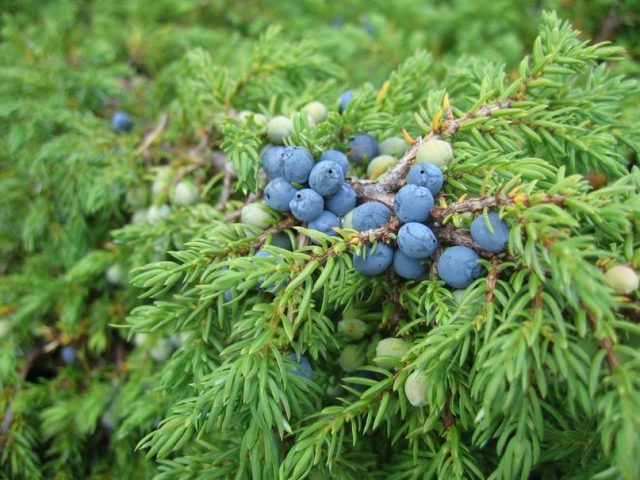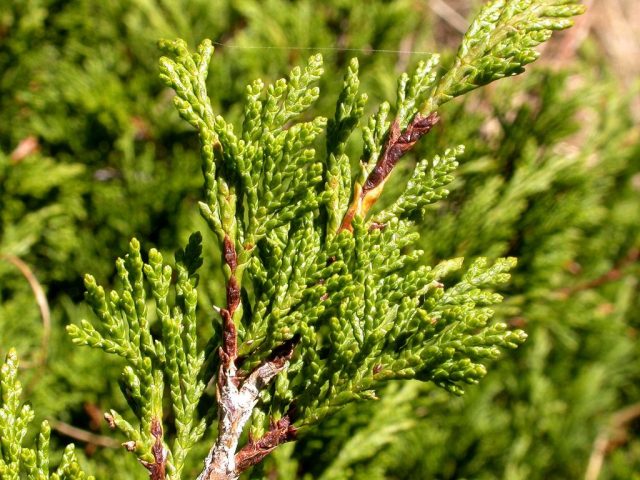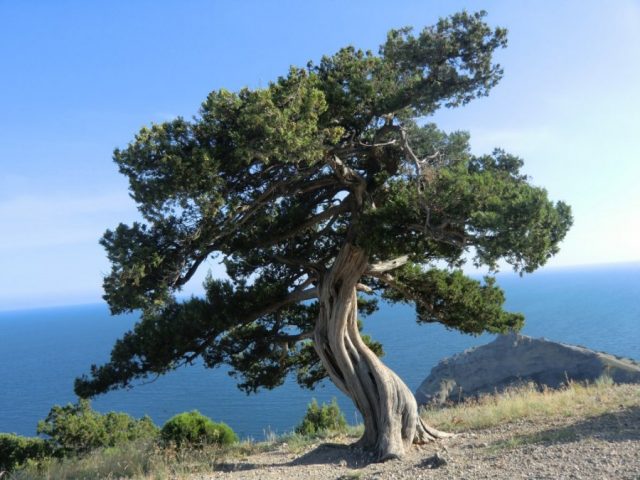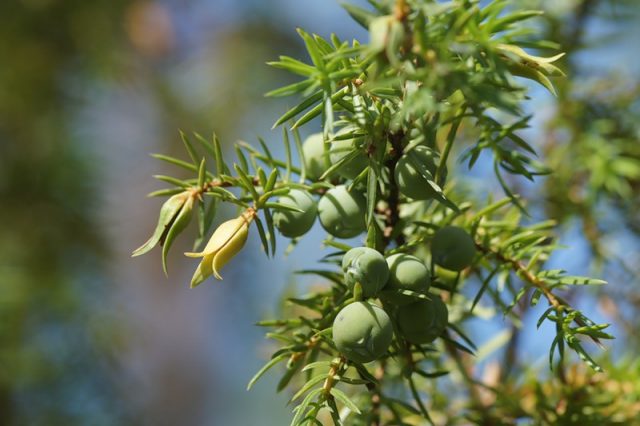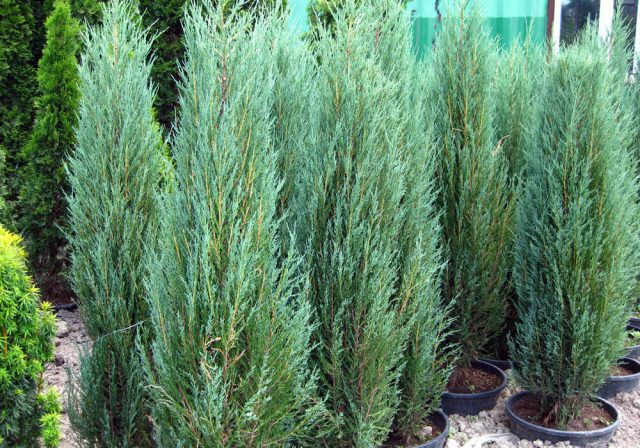Content
Juniper is a common and unique plant at the same time. It harmoniously combines beauty and benefits, therefore it is used for decorative and medical purposes. Meanwhile, many do not even know what a juniper looks like and where it grows.
Juniper origin
Juniper has quite a few synonyms. In many sources it is referred to as veres (not to be confused with heather - a flower plant), in the literature there is also another name for it - juniper. In common people, a juniper is often called a walrus or a bougier. The plant has been known since ancient times for its medicinal properties. Mentions of him are found in the myths of Ancient Greece and the writings of the ancient Roman poet Virgil, as well as in Slavic mythology.
Below in the photo is a tree and juniper leaves.
Its distribution area is quite wide. It is found in almost the entire Northern Hemisphere, from the Arctic to North Africa. It also grows in North America, the USA and Canada. There are more than 70 species of both wild and decorative ones.
Juniper appearance
Juniper, photo and description of which are presented below, belongs to the genus Cypress. It is a shrub that, depending on the species and place of growth, can have different shapes and sizes. In the southern regions, it is most often found in a tree-like form, in the north - as a low bush. There are also many decorative species of this shrub, the appearance of which is formed and regulated by pruning or shearing.
Description of the tree
The common juniper according to the description is a low evergreen coniferous shrub with a height of 1 to 3 m. It is characterized by slow growth and a significant life expectancy - up to 500 years. The crown is usually round, less often conical. The lower branches are often drooping.
Juniper coloring
Young shoots are brown with a reddish tint, the bark of an adult tree is gray, dark, sometimes with a brown tint. The color of the juniper depends on the place of growth and weather conditions, as well as on the season. It is associated with the release of a wax-like substance by leaves that scatters light in a certain way. Depending on its presence, the needles can have bluish, yellowish, whitish shades.
In addition to chlorophyll and wax, the leaves of this plant synthesize anthocyanins - substances that protect against ultraviolet radiation. Their number increases in autumn and during the drought period, and since their color is red-violet, in combination with green they give a characteristic bronze tint, which many species of this plant acquire in the pre-winter period.
What juniper berries look like
This shrub can be both monoecious and dioecious. Male cones are small, deep-seated, yellowish. Cones of the female type (cones) are more numerous, they are ovoid or spherical, about 1 cm in size.At first they are light green in color, later they become blue-black with a bluish sheen, there is a bluish waxy bloom on the surface.
Cones ripen in the second year. Each of them contains from 1 to 10 seeds. They are small, triangular, easily carried by the wind. Juniper cones are not full-fledged berries, they are accrete cones, therefore this plant does not belong to angiosperms, but to gymnosperms.
Juniper leaf description
The leaves of heather, depending on the species and age, are acicular or scaly. In common juniper, they are triangular needles. They are tough, prickly, 1-1.5 cm long and about 1 mm wide. They survive on shoots up to 4 years. The green tissues of the leaf are covered with a layer of waxy coating, which can give the needles different shades of color: light green, bluish or golden. Species with scaly needles grow mainly in the southern regions.
What are the names of juniper leaves
Depending on the species and age, the leaves of this plant are called needles or scales. But these are precisely the leaves that have an elongated-lanceolate shape. In common people I call them needles, by analogy with ordinary conifers, such as spruce or pine.
How does a juniper grow?
In nature, this evergreen shrub reproduces only by seeds. They have a rather low germination rate, and even at home they do not always germinate. Often, sprouts may appear only a few years after the seed has entered the soil. In the first years the bush grows quite actively, then the rate of its growth slows down. Most species of this plant add only 1 to 10 cm per year.
Juniper is a tree or shrub
Juniper, especially many ornamental varieties, often looks like a small tree by description, although it is a coniferous evergreen shrub, since its appearance is highly dependent on growing conditions. In the Mediterranean, there are large tree-like specimens that grow up to 15 m in height.
In northern latitudes, this plant grows in the form of a low or creeping low-growing bush with creeping shoots.
Juniper coniferous or deciduous tree
When asked whether a juniper is a coniferous or flowering plant, there is an unequivocal answer. Like all plants of the Cypress genus, this shrub belongs to the coniferous species.
How much does a juniper grow
In the mythology of many peoples, this shrub is a symbol of immortality. This is due to its long life span. Under normal conditions, the age of plants can reach 500-600 years, and in some sources millennial juniper trees are also mentioned.
Where does juniper grow in Russia
This shrub grows practically throughout the entire forest-steppe territory of Russia, with the exception of the polar regions and high mountains. It can be found in the lower tier of light deciduous and pine forests of the European part, the foothills of the Urals and the Caucasus, in Siberia to the Lena River basin. In some regions, the winter hardiness zone of juniper goes even beyond the Arctic Circle. It grows well in almost all types of soil, with the exception of wetlands, since it does not tolerate excess moisture. It prefers light areas, so often clearings, clearings, forest edges or roadsides become the habitat of junipers.
How and when the juniper blooms
Heather blooms, or as they say, dusty in April-May, and in the Siberian region - in June. Flowers are small cones-spikelets. Cones of the female type are green, sitting in groups, male spikelets are yellow, elongated.
Juniper blooms are usually unnoticeable.
What does juniper smell like?
The smell of this shrub is highly dependent on its species. In most varieties, it is memorable, coniferous, bright, but at the same time delicate.This property is also preserved by wood, therefore, products from juniper wood retain this warm and pleasant smell for a long time. You can smell this plant by smelling natural gin, which is juniper vodka. Some species, such as Cossack and Smelly, have a sharper and more unpleasant aroma that can be felt when rubbing the needles.
Juniper is poisonous or not
Among the many species of this evergreen shrub, only one is non-poisonous - the common juniper. All other species are toxic to one degree or another. The most poisonous of all is the Cossack juniper. You can distinguish it by the strong unpleasant odor that its needles emit. The rest of the species are less poisonous. Both berries and shoots have toxic properties, since they contain a poisonous essential oil.
Nevertheless, if you follow basic precautions and do not try to taste all parts of the plant, then you can safely grow a wild or cultivated juniper in your garden plot.
Interesting facts about juniper
The healing properties and longevity have given rise to many rumors and legends about this plant. However, the juniper can really be called unique without exaggeration. Here are some interesting facts about this evergreen shrub:
- According to archaeological excavations, the juniper appeared about 50 million years ago.
- The oldest known juniper is found in the Crimea. Its age, according to some sources, is about 2000 years.
- The leaves of this plant emit a large amount of air disinfecting substances - phytoncides. For a day, 1 hectare of juniper forest synthesizes about 30 kg of these volatile compounds. This amount is enough to kill all pathogenic bacteria in the air of a large metropolis, such as, for example, Moscow.
- If you steam wooden tubs for pickling vegetables or mushrooms with a juniper broom, then mold will not start in them.
- Milk never turns sour in barrels made of juniper bark. Even in the heat.
- Moth never grows in juniper wood cabinets. Therefore, twigs of this shrub are often kept in boxes with clothes.
- The berries (cones) of the common juniper are used both in medicine and in gastronomy, as a seasoning for meat and fish.
- Veres wood retains its specific coniferous smell for a very long time. Therefore, for example, in Crimea, crafts are often made from it for tourists.
- The use of the berries of this plant is categorically contraindicated for pregnant women, as it can provoke a miscarriage.
- Cuttings of this plant have an interesting feature, which can be used for reproduction of the species. If you cut them from the top of the bush, then the seedling will tend to grow upward. If you use cuttings from the side branches, then the young plant will grow in breadth.
- The roots of this plant have good holding capacity, so the bushes are often planted to anchor the soil on slopes and embankments.
- Juniperus virginiana is often called the "pencil tree" because its wood is used to make pencils.
- The thickets of this shrub are one of the signs of the close occurrence of the coal seam. Thanks to this property, the Moscow Region coal basin was opened.
Juniper has always been a symbol of life and longevity. In the old days, a twig of this plant was often kept behind an icon. It is believed that seeing this evergreen shrub in a dream is a sign of wealth and good luck.
Conclusion
In the specialized literature, you can find detailed information about what a juniper looks like, where it grows and how it is used. This article lists only the main properties of this thorny relative of the cypress.This plant is indeed in many ways unique in its properties, and a close acquaintance with it will undoubtedly benefit anyone.
